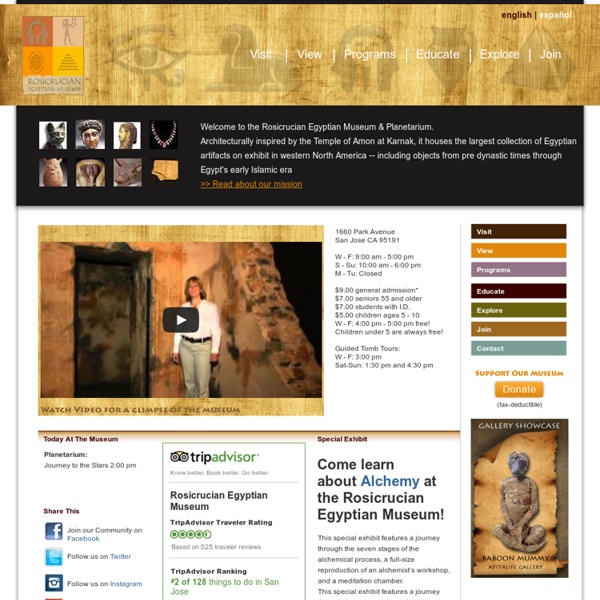



Oriental Institute Chicago Print this Page Home > Museum > Joseph and Mary Grimshaw Egyptian Gallery The Joseph and Mary Grimshaw Egyptian Gallery of the Oriental Institute opened to the public on May 29, 1999 following a three year renovation project. The 4000-square foot gallery displays approximately 800 objects dating from the Predynastic Period (ca. 5000 B.C.) to the Arab conquest (7th century A.D.). The installation of climate control systems to the museum enabled many fragile objects of cloth, wood, rush, and papyrus to be exhibited for the first time. To compare the old installation to the new, go to the Oriental Institute Virtual Museum. Colossal statue of king Tutankhamun excavated by the Oriental Institute at Medinet Habu in 1930. Detail of a display on Egyptian chronology that exhibits the most characteristic objects from each time period. Detail of a display on Egyptian chronology that exhibits the most characteristic objects from each time period.
Ancient Egypt Egypt's impact on later cultures was immense. You could say that Egypt provided the building blocks for Greek and Roman culture, and, through them, influenced all of the Western tradition. Today, Egyptian imagery, concepts, and perspectives are found everywhere; you will find them in architectural forms, on money, and in our day to day lives. Many cosmetic surgeons, for example, use the silhouette of Queen Nefertiti (whose name means “the beautiful one has come”) in their advertisements. Pyramid of Khafre at Giza, c. 2520-2494 (right). Photo: Dr Amy Calvert, CC BY-NC This introduction will provide you with the primary filters to view and understand ancient Egypt. Longevity Ancient Egyptian civilization lasted for more than 3000 years and showed an incredible amount of continuity. Consistency & Stability Egypt’s stability is in stark contrast to the Ancient Near East of the same period, which endured an overlapping series of cultures and upheavals with amazing regularity. Geography Dynasties
San Jose Historical Museum Brooklyn Museum Highlights – Showing objects 1 - 12 of 20 Warning: include(/home/www/blogosphere/wp-content/themes/clipboard/single-content.php): failed to open stream: No such file or directory in /home/www/default/data/includes/get_wordpress_posts.php on line 45 Warning: include(): Failed opening '/home/www/blogosphere/wp-content/themes/clipboard/single-content.php' for inclusion (include_path='.:/home/www/default/lib:/home/www/default/data/includes') in /home/www/default/data/includes/get_wordpress_posts.php on line 45 Go to the original blog post Go to the original blog post Go to the original blog post Go to the original blog post Go to the original blog post Recent Blog Posts The End of the Season Working together with the ARCE project team we got a great deal accomplished this season in preparing the site to open to visitors. Our last week of excavation Our last day of excavation was February 28, but we still have work to do. Back at Mut – How things have changed!
Sumerian Myths Sumerian civilization originated in what is now southern Iraq, just upriver from the mouths of the Tigris and Euphrates rivers. "Civilization" in this context means a settled town or city-dwelling people who possess a stable agricultural technology (including domesticated animals) and have developed a hierarchical system of social classes (peasants, laborers, slaves, craftsmen [smiths, masons, carpenters, potters, etc.], farmers, fishermen, merchants, doctors, architects, priests and temple attendants, bureaucrats, scribes, advisers, priest-kings). Since the climate of southern Iraq is hot and dry, agriculture requires an extensive irrigation system of canals and dikes. Map of Mesopotamian Archeological Sites (Oriental Institute, University of Chicago) Sumerian cities were close agglomerations of one or two story mud brick dwellings. The Sumerian CreationOnly one account of the Sumerian creation has survived, but it is a suggestive one. The Creation of Humans Questions:1. 2. 3. 4. 5.
Lich Observatories Society for the Study of Egyptian Antiquities - Montreal Chapter Passons-y un moment! Let's tarry here for a while! What it Is Ancient Egypt has fascinated the public ever since ancient times, particularly since it was rediscovered by the west just over 200 years ago. Since its launch in September 2006, In Search of Ancient Egypt in Canada has been identifying and describing Egyptian artefacts in museums across Canada. Name of the Museum Address Telephone, E-mail, and Website if applicable Person in charge (curator, director, other. History of the Museum relevant information such as founders, milestones in development, focus of the collection, size overall Exterior picture of the museum History of the Egyptian collection or items range of items (by type, period, etc.) if applicable, picture of the gallery “Featured” items that the museum wishes to display brief description, including size Name of the Site Address/location Telephone, E-mail, or Website if applicable History of the Site relevant information such as architect and/or designer and/or artist Funerary Dr.
Happy Hallow Park and Zoo Wikipedia History[edit] The roots of the Brooklyn Museum extend back to the 1823 founding by Augustus Graham of the Brooklyn Apprentices’ Library in Brooklyn Heights. The Library moved into the Brooklyn Lyceum building on Washington Street in 1841; the institutions merged two years later to form the Brooklyn Institute, which offered exhibitions of painting and sculpture and lectures on diverse subjects. Opened in 1897, the Brooklyn Museum building is a steel frame structure—built to the standards of classical masonry—designed by the famous architectural firm of McKim, Mead, and White and built by the Carlin Construction Company. The Brooklyn Institute's director Franklin Hooper was the museum's first director, succeeded by William Henry Fox who served from 1914-1934. Thomas S. From 1971–1973 Duncan F. The Brooklyn Museum changed its name to Brooklyn Museum of Art in 1997, shortly before the start of Arnold L. Funding[edit] Major benefactors include Frank Lusk Babbott. Art and exhibitions[edit]